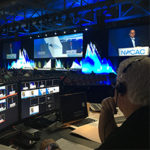 Remember when we used to talk about how trying to keep up with online information felt like drinking out of a fire hose? Given the overflow of new ideas, information, and opinions stuffing our social-media channels and inboxes, that almost sounds manageable now. So, as we — Convene‘s five on-staff writers and editors — looked back over 2016, we asked ourselves this question: What’s one meeting trend we’ll be keeping an eye on next year?
Remember when we used to talk about how trying to keep up with online information felt like drinking out of a fire hose? Given the overflow of new ideas, information, and opinions stuffing our social-media channels and inboxes, that almost sounds manageable now. So, as we — Convene‘s five on-staff writers and editors — looked back over 2016, we asked ourselves this question: What’s one meeting trend we’ll be keeping an eye on next year?
ROBOTS AND OTHER NEXT-GEN TOOLS
Michelle Russell, Editor in Chief
I expect that high-tech events themselves will help transition the rest of the events space into using next-gen tools. How can hosting events that showcase the latest technologies not rub off on convention centers? How can business event organizers in high-tech sectors not incorporate bleeding-edge tools in their own event design and session rooms — which then seep into other kinds of events not directly associated with technology? And as far as the influence high-tech hubs like Silicon Valley wield over their destinations’ infrastructure, consider how Mineta San Jose Airport pressed three robots into service as customer service agents this past October. Watch for us to follow up on the ways our industry makes futuristic elements part of the meetings landscape in 2017.
MEETINGS WILL MATTER MORE THAN EVER
Chris Durso, Executive Editor
I’m a terrible trend spotter. When we did this last year, I sidestepped the issue and offered not so much a trend as a prayer of hope for 2016. I’m going to do the same thing for 2017, but even more earnestly: After a long and unsettling year, I hope that meetings, conferences, and other business events help remind people of the common humanity and innate decency they share with almost everyone else across the country and around the world. Look for a cover story about this in our February issue — less saccharine and more clear-eyed than what I’ve written here, but based on the same notion: that getting people together for pretty much any reason can make the world a better place.
‘FLIPPED LEARNING’ WILL FEEL LESS LIKE HOMEWORK
Barbara Palmer, Senior Editor & Director of Digital Content
Flipped learning upends traditional teaching by providing lecture material via video and using class-time for hands-on learning. And according to Campus Technology’s 2016 Teaching With Technology Survey, 55 percent of higher-education faculty now use flipped learning in all or some of their classes. That means an ever-accelerating number of meeting participants will be primed for both video and participatory learning, not to mention impatient with meetings that don’t make the most of face-to-face time.
I am looking for this to converge with another big trend: the evolution of digital-storytelling tools. Video lectures don’t have to look or feel anything like traditional classroom lectures, and I will be looking for new digital-storytelling techniques to make their way into online content aimed at adult learners and communities. I recently saw one illuminating example of the power of video to both distill speakers’ messages and enable face-to-face interaction at the 2016 Future of Storytelling Festival (FoST) — look for more about FoST in our January issue.
THE INTERNET OF THINGS TOUCHES ALMOST EVERYTHING
Corin Hirsch, Associate Editor
There are roughly 12 billion IoT-connected devices in the world, from Fitbits to kitchen appliances. As of 2016, that number included thousands of sensors attached to honeybees — “bee backpacks” — by researchers trying to discern the causes of colony-collapse disorder. When tiny, kinetic bees can be fitted with sensors, then IoT must be hitting its stride. With the cost of sensors falling and screaming-fast 5G technology on the horizon, IoT will spike exponentially in the next year or two — especially at meetings, as RFID name tags and beacons become more affordable and accessible.
COFFEE GOES CRAFT
David McMillin, Contributing Convene Editor and PCMA Writer
Attendees have already shifted their preferences for beverages at evening receptions to microbrews and locally distilled spirits. In 2017, we’ll see a movement toward changing the morning routine as an increasing number of attendees aim to satisfy their caffeine cravings with something other than massive one-cup-fits-all coffee urns. Research from the Specialty Food Association predicts a 35-percent surge in consumer coffee sales from 2015 to 2020. That growth isn’t simply because they’re buying more coffee; it’s because they’re buying more expensive offerings made by names like Intelligentsia, Blue Bottle, and Stumptown. Expect to see more organizations make room for pop-up coffee stations from local roasters in the new year.



